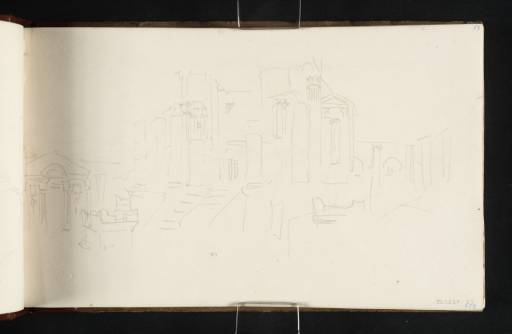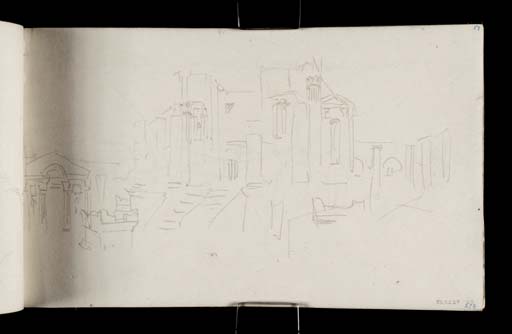Joseph Mallord William Turner The Temple of Isis, Pompeii 1819
Image 1 of 2
Joseph Mallord William Turner,
The Temple of Isis, Pompeii
1819
Joseph Mallord William Turner 1775–1851
Folio 17 Recto:
The Temple of Isis, Pompeii 1819
D15768
Turner Bequest CLXXXV 17
Turner Bequest CLXXXV 17
Pencil on white wove paper, 113 x 189 mm
Inscribed by ?John Ruskin in blue ink ‘278’ bottom right and ‘17’ top right
Stamped in black ‘CLXXXV 17’ bottom right
Stamped in black ‘CLXXXV 17’ bottom right
Accepted by the nation as part of the Turner Bequest 1856
References
1909
A.J. Finberg, A Complete Inventory of the Drawings of the Turner Bequest, London 1909, vol.I, p.547, as ‘Do. [Ruins]’.
1984
Cecilia Powell, ‘Turner on Classic Ground: His Visits to Central and Southern Italy and Related Paintings and Drawings’, unpublished Ph.D thesis, Courtauld Institute of Art, University of London 1984, pp.186 note 74, 491 note 32.
1987
Cecilia Powell, Turner in the South: Rome, Naples, Florence, New Haven and London 1987, pp.79 note 25, [82] note 60.
One of the first structures to be excavated after the re-discovery of Pompeii during the late eighteenth century was the Temple of Isis, a small but ornate Roman temple dedicated to the eponymous Egyptian goddess.1 Not only one of the earliest landmarks to be uncovered, the temple also represents one of the most complete surviving buildings in Pompeii and its discovery had an immediate impact on artistic culture.2 The composer, Mozart (1756–1791), for example, is known to have visited the site in 1769 and his experiences may be reflected in the 1791 opera, The Magic Flute.3 The temple also quickly became one of the most popular subjects for artists.4 Turner’s study reflects an established pictorial tradition of depicting the building from the entrance to the porticoed courtyard so that the temple itself is diagonal to the picture plane with the purgatorium (a fenced area with water basin) and altar on the left.5
For further sketches and a general discussion of Turner’s visit to Pompeii see the introduction to the sketchbook.
Nicola Moorby
September 2010
See Roberto Cassanelli, Pier Luigi Ciapparelli, Enrico Colle et al., Houses and Monuments of Pompeii: The Works of Fausto and Felice Niccolini, Los Angeles 1997, p.218.
See Matheus Franciscus Maria Berk, ‘Mozart Visits the Isis Temple in Pompeii’, in The Magic Flute, Leiden 2004, pp.450–8.
See for example the engraving after Pietro Fabris, ‘Excavation of the Temple of Isis at Pompeii’ for Campi Phlegraei, published 1776, reproduced in Ian Jenkins and Kim Sloan, Vases and Volcanoes: Sir William Hamilton and his Collection, London 1996, fig.14, p.42; also an ‘Interior View of the Chapel of Isis’ in William Hamilton, Account of the Discoveries at Pompeii, London 1777, pl.VI.
The viewpoint and composition is virtually identical to an engraving by G. Hollis, ‘View in the Court of the Temple of Isis’, published February 1819, reproduced in Sir William Gell and Joseph Gandy, Pompeiana: The Topography, Edifices, and Ornaments of Pompeii, London 1824, vol.II, pl.69, between pp.258–9. See also the engraved plate after a drawing by Major James Cockburn, ‘Temple of Isis’, first published 1819, in Pompeii, Illustrated with Picturesque Views, Engraved by W.B. Cooke, from the Original Drawings of Liet. Col. Cockburn, of the Royal Artillery, vol.I, London 1827, p.[43].
How to cite
Nicola Moorby, ‘The Temple of Isis, Pompeii 1819 by Joseph Mallord William Turner’, catalogue entry, September 2010, in David Blayney Brown (ed.), J.M.W. Turner: Sketchbooks, Drawings and Watercolours, Tate Research Publication, December 2012, https://www


